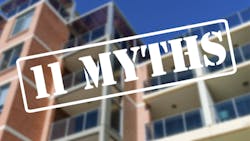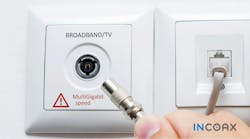11 Myths About Multi-Dwelling Unit Connectivity
What you’ll learn:
- How those residing in apartment complexes or hotel blocks don’t always have the seamlessly connectivity that you might think.
- Why solutions can be found in the property rather than installing fiber.
- Understand the typical problems surrounding connectivity in MDUs, along with common misunderstandings and exaggerations.
Connectivity in multi-dwelling units (MDUs) can be a challenge. Optical fiber is often touted as the latest and greatest, but is it always necessary? More than 30% of Americans lived in MDUs and they need high-speed internet connections. Debunking myths about MDU connectivity can help answer these questions.
1. Consumers only care about having fiber.
While fiber offers greater speed, consumers are typically looking beyond pure speed when it comes to their broadband experience. The likes of greater reliability and lower latency, for those streaming or gaming, become key considerations when it comes to broadband packages, regardless of the technology in use.
For example, Broadband Forum, a standards development organization, is helping deliver a richer, more tailored broadband experience for the consumer rather than fast speeds alone. The group recently announced that all new projects will focus on enabling intelligent broadband that provides the applications and services most demanded by consumers.
Consumers in general are technology agnostic and focus on the network’s performance. Greater reliability and lower latency—especially important for streaming or gaming—rank high. Improved broadband can significantly increase a property's appeal. In one real-world case, an affordable housing complex in Austin, Texas, saw its vacancy rate drop from 50% to just 11% after broadband was upgraded using existing infrastructure and the MoCA Access 2.5 technology standard.
2. Fiber is cheaper than the alternatives.
Due to installation, material, and labor costs, fiber is often twice as expensive compared to using the existing in-building infrastructure, such as the coaxial network. Alongside that, the technology equipment as part of the upgrade can be considerable. Any approach to deliver fast connectivity without incurring the costs typically involved in fiber rollouts should be explored by internet service providers (ISPs).
3. All copper broadband is the same.
Copper-based broadband technologies are often unfairly grouped and dismissed as old, expensive, and slow. In reality, the performance differences between copper solutions as twisted pairs compared to coaxial networks are substantial, and modern standards can rival fiber for speed and reliability in many deployment scenarios.
Understanding these differences is important. Not all copper is created equal. Selecting the right technology can mean faster speeds, lower costs, and quicker deployments for ISPs and property owners alike.
4. Those who live in multi-dwelling units have good connectivity.
In 2023, more than 30% of Americans lived in MDUs, such as apartments and condos, which typically lag behind in high-bandwidth connectivity compared to standard housing or single-family units (SFUs). This is due to legacy infrastructure in the premises, such as copper cabling, rather than fiber connectivity.
5. New builds aren’t automatically kitted out with fiber.
In the UK, for example, the overwhelming majority of new homes have infrastructure to support gigabit fiber speeds up to 1 Gb/s. Newer MDU builds in the United States are installed with fiber to boost property appeal and rental value. Meanwhile, retrofitting older brownfield MDUs is a much less attractive proposition for broadband service providers (BSPs).
6. MDUs are easily accessible.
Several factors make MDUs difficult to access. These include gaining the relevant permissions from the building owner to install fiber, or the landowner approving work to be undertaken. The customer may also not agree to an installer entering or carrying out construction work on the walls of their apartment.
Landlords can sometimes understandably be cautious in allowing access, and fiber connectivity may not lead the way in terms of priority for landlords.
7. Installing connectivity to apartment complexes and hotel blocks is straightforward.
It can be costly for those tasked with installing improved connectivity in dense, urban areas such as apartment blocks. Cosmetic damage and disruption may be significant when rewiring fiber, and this can even put off ISPs before work has begun. Adhering to strict safety measures and overcoming any construction risks or building regulations presents a difficult obstacle for ISPs.
There could also be a high expense associated with the building and a low return on investment (ROI) if there’s a low number of occupants in the MDU. Other issues include a skilled labor shortage to install the fiber, or no permission from the local government for the civil works.
So, while you might not think about it, those dwelling in apartment blocks may not have the lightning-fast speeds that we assume they have.
8. Fiber-to-the-premises deployment is the only way for tenants to receive gigabit connectivity.
Tenants can still receive gigabit speeds if fiber reaches close to the building and the existing coaxial cabling is used for the last hundred meters (“the last mile”). Typically, the fiber build in the last hundred meters is notoriously difficult.
9. Deployment of broadband connectivity must be expensive in those MDU buildings
While typical fiber deployments involve considerable costs and need a high take-up rate to ensure that they remain in the green in terms of profitability, there are already tools to support fiber rollouts.
With a lot of brownfield MDU buildings, the network infrastructure is largely already there. Coaxial cabling extending to each apartment from the basement is generally intact. ISPs can even deploy access extension technology and use this existing in-building coaxial cabling to deliver multi-gigabit connectivity that tenants may previously have not been lucky enough to receive.
10. Tenants of apartment complexes have always been able to easily change their broadband service.
Nearly half a million MDUs exist in the UK, and typically they have had to wait for the landlords’ permission for an ISP to enter a property and install connectivity. It’s estimated that nearly half of ISP requests for access received no response, effectively ending the possibility of installing connectivity.
ISPs have pointed to an expensive and time-consuming process of attempting to contact landlords and managing agents of buildings. Simply put, this means that millions of apartments may be bypassed, even if the surrounding houses on the same street already have fiber connectivity.
11. No laws are being put into effect to help tenants.
In 2024, a new bill was passed (Telecommunications Infrastructure (Leasehold Property) Act (TILPA)) in the UK that ensures tenants can receive a broadband upgrade irrespective of their landlord’s silence. ISPs can now gain access to a block of apartments 35 days after the tenant’s request to the landlord. It’s estimated that an additional 2,100 UK residential buildings a year will now be connected as a result.
As recently as March 2025, a new amendment to the Renters’ Rights Bill means landlords must accept the request from their tenants. Landlords can no longer “unreasonably refuse” access from ISPs to a rented property for a broadband upgrade.
Last year, the FCC proposed banning bulk billing arrangements. This was part of the efforts to ensure that tenants weren’t locked into agreements with only one ISP due to the building or apartment owners’ preference.
About the Author

Helge Tiainen
Business Development Director, InCoax Networks
Helge Tiainen is a Business Development Director at InCoax Networks and has been with the company since 2009. Helge is responsible for developing sales and marketing of existing products and new business opportunities among cable, telecom, and mobile operators He develops use cases and technologies within standards organizations as Broadband Forum, MoCA Alliance, Fiber Broadband Association, and other working groups. Helge also manages partnerships of key technology partners suited with InCoax initiatives.


